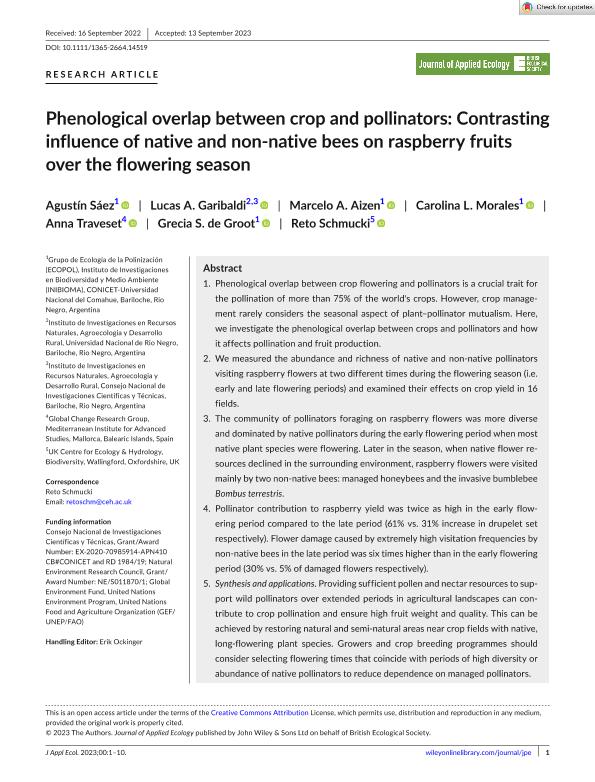Artículo
Phenological overlap between crop and pollinators: Contrasting influence of native and non-native bees on raspberry fruits over the flowering season
Sáez, Agustín ; Garibaldi, Lucas Alejandro
; Garibaldi, Lucas Alejandro ; Aizen, Marcelo Adrian
; Aizen, Marcelo Adrian ; Morales, Carolina Laura
; Morales, Carolina Laura ; Traveset, Anna; de Groot, Grecia Stefanía
; Traveset, Anna; de Groot, Grecia Stefanía ; Schmucki, Reto
; Schmucki, Reto
 ; Garibaldi, Lucas Alejandro
; Garibaldi, Lucas Alejandro ; Aizen, Marcelo Adrian
; Aizen, Marcelo Adrian ; Morales, Carolina Laura
; Morales, Carolina Laura ; Traveset, Anna; de Groot, Grecia Stefanía
; Traveset, Anna; de Groot, Grecia Stefanía ; Schmucki, Reto
; Schmucki, Reto
Fecha de publicación:
10/2023
Editorial:
Wiley Blackwell Publishing, Inc
Revista:
Journal of Applied Ecology
ISSN:
0021-8901
Idioma:
Inglés
Tipo de recurso:
Artículo publicado
Clasificación temática:
Resumen
Phenological overlap between crop flowering and pollinators is a crucial trait for the pollination of more than 75% of the world's crops. However, crop management rarely considers the seasonal aspect of plant–pollinator mutualism. Here, we investigate the phenological overlap between crops and pollinators and how it affects pollination and fruit production. We measured the abundance and richness of native and non-native pollinators visiting raspberry flowers at two different times during the flowering season (i.e. early and late flowering periods) and examined their effects on crop yield in 16 fields. The community of pollinators foraging on raspberry flowers was more diverse and dominated by native pollinators during the early flowering period when most native plant species were flowering. Later in the season, when native flower resources declined in the surrounding environment, raspberry flowers were visited mainly by two non-native bees: managed honeybees and the invasive bumblebee Bombus terrestris. Pollinator contribution to raspberry yield was twice as high in the early flowering period compared to the late period (61% vs. 31% increase in drupelet set respectively). Flower damage caused by extremely high visitation frequencies by non-native bees in the late period was six times higher than in the early flowering period (30% vs. 5% of damaged flowers respectively). Synthesis and applications. Providing sufficient pollen and nectar resources to support wild pollinators over extended periods in agricultural landscapes can contribute to crop pollination and ensure high fruit weight and quality. This can be achieved by restoring natural and semi-natural areas near crop fields with native, long-flowering plant species. Growers and crop breeding programmes should consider selecting flowering times that coincide with periods of high diversity or abundance of native pollinators to reduce dependence on managed pollinators.
Archivos asociados
Licencia
Identificadores
Colecciones
Articulos (IRNAD)
Articulos de INSTITUTO DE INVESTIGACIONES EN RECURSOS NATURALES, AGROECOLOGIA Y DESARROLLO RURAL
Articulos de INSTITUTO DE INVESTIGACIONES EN RECURSOS NATURALES, AGROECOLOGIA Y DESARROLLO RURAL
Citación
Sáez, Agustín; Garibaldi, Lucas Alejandro; Aizen, Marcelo Adrian; Morales, Carolina Laura; Traveset, Anna; et al.; Phenological overlap between crop and pollinators: Contrasting influence of native and non-native bees on raspberry fruits over the flowering season; Wiley Blackwell Publishing, Inc; Journal of Applied Ecology; 2023; 10-2023; 1-10
Compartir
Altmétricas
Items relacionados
Mostrando titulos relacionados por título, autor y tema.
-
Moré, Marcela; Ibañez, Ana Clara ; Drewniak, María Eugenia ; Cocucci, Andrea Aristides ; Raguso, Robert A. (Frontiers Media S.A., 2020-12)
-
Delgado-Carrillo, Oliverio; Martén-Rodríguez, Silvana; Ashworth, Lorena ; Aguilar, Ramiro ; Lopezaraiza-Mikel, Martha; Quesada, Mauricio (Wiley-Blackwell, 2018-11)



